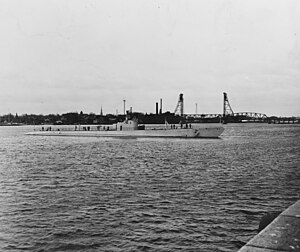 USS Cachalot (SS-170) the lead boat of the class
| |
| Class overview | |
|---|---|
| Name | Cachalot class |
| Builders | |
| Operators | |
| Preceded by | USS Dolphin (SS-169) |
| Succeeded by | Porpoise class |
| Built | 1931-1934 |
| In commission | 1933-1945 |
| Completed | 2 |
| Retired | 2 |
| General characteristics | |
| Type | Submarine |
| Displacement |
|
| Length | 260 ft (79 m) waterline, 274 ft (84 m) overall |
| Beam | 24 ft 1 in (7.34 m) |
| Draft | 13 ft 10 in (4.22 m) |
| Propulsion |
|
| Speed |
|
| Range | |
| Endurance | 10 hours at 5 knots (9.3 km/h) submerged |
| Test depth | 250 ft (76 m) |
| Complement | 6 officers, 39 men (peacetime); 7 officers, 48 men (war)[5] |
| Armament |
|
The Cachalot-class submarines were a pair of medium-sized submarines of the United States Navy built under the tonnage limits of the London Naval Treaty of 1930. They were originally named V-8 and V-9, and so were known as "V-boats" even though they were unrelated to the other seven submarines (V-1 through V-7) constructed between World War I and World War II. An extensive study was conducted to determine the optimum submarine size under the treaty restrictions, factoring in total force, endurance, and percentage of the force that could be maintained on station far from a base, as in a Pacific war scenario.[7] Joseph W. Paige[5] of the Navy's Bureau of Construction and Repair (BuC&R) developed the basic design, but the builder, Electric Boat, was responsible for detailed arrangement; this was fairly bold, since Electric Boat had not built any new submarines since finishing four obsolescent boats for Peru. The previous V-boats were all built in naval shipyards. Cuttlefish was the first submarine built at EB's facility in Groton, Connecticut; construction of previous Electric Boat designs had been subcontracted to other shipyards, notably Fore River Shipbuilding of Quincy, Massachusetts.[5][8]
- ^ a b Alden, p.210.
- ^ Friedman, p. 310
- ^ Alden, p.211.
- ^ Alden, John D., Commander, USN (retired). The Fleet Submarine in the U.S. Navy (Annapolis, MD: Naval Institute Press, 1979), p.211.
- ^ a b c d e Alden, p.38.
- ^ Leton, H.T. American Submarines (Doubleday, 1973), p.37.
- ^ Friedman, pp. 189-193
- ^ Friedman, p. 193